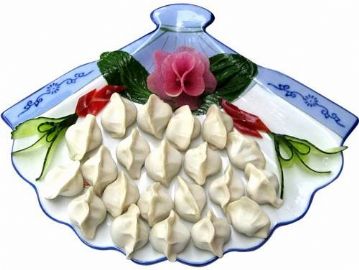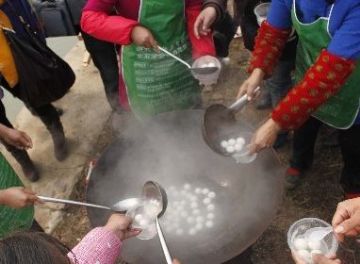| 图片: | |
|---|---|
| 名称: | |
| 描述: | |
- 是吃饺子的时候了
虎年的钟声即将敲响,全国上下,一派欢乐祥和!
不知道远在异国他乡的华夏儿女们此刻都在忙些什么?我想不管身处何地,新年里包饺子、吃饺子可能是我们共同的心愿和爱好。那就让我们在饺子的温暖中一起分享这份团圆的美好。。。
祝所有华夏老师们春节愉快、阖家幸福!
Tis time for dumplings
While rice is a staple food for southerners, (defined as those living south of the Yangtze River), the northern Chinese prefer noodles and dumplings.
Jiaozi, or dumplings, take on many forms, their shapes shifting as they pass through the provinces in the northeast or north. But whatever their form, the traditions that go with them do not change.
Take feasting during the Spring Festival. On the eve of Lunar New Year, most families keep vigil way past midnight, with every light in the house blazing. This custom is especially important for extended families with elderly members since it is believed the vigil will ensure the old folks have many healthy, happy years ahead of them.
Making dumplings together is one way to keep oneself occupied during the long vigil.
After the reunion dinner, the head of the family will bring out the flour and start kneading dough, rolling out little wrappers which the womenfolk will quickly fill with succulent meat and vegetables. The dumplings will have to keep for the next few days, when the house will be full of visitors, leaving little time for the kitchen.
But it is not just during festive occasions that we eat jiaozi. It is a food for all occasions, merry or sad.
When my husband and I return to Beijing from our visits home, my sisters-in-law and aunt will start piling up the dumplings even before the luggage is unpacked.
The first meal - to welcome us home - will be jiaozi. And when it is time for us to leave, we'll have jiaozi again - to send us off on the road. And so it goes for birthdays, weddings, births and deaths. Jiaozi are eaten with joy in health and happiness, and for comfort during goodbyes.
The dough is almost always made from wheat flour, which most families buy by the bag. The filling varies with the seasons.
In summer, French beans, long beans, broad beans or fennel tops are minced with pork or lamb. In winter, cabbages, radishes and pumpkins are more common. In my family, our sisters also make a vegetarian version - using scrambled eggs, bean curd and garlic chives.
The main flavoring is Sichuan pepper - a spice which arrived with migrant workers - which has been adopted with great enthusiasm. A handful is steeped in hot oil and then the fragrant oil is used as the main aromatic.
Northerners like their dumplings boiled, and served with dips, such as chopped garlic in black vinegar. But, my favorite dip is the beautifully pungent, pickled flowering chives. It has a unique aroma that is almost impossible to describe.
There is no mystery to making jiaozi. The dough is easily done and all you need is enough elbow grease to make it smooth and pliable.
As for the filling, follow the basic steps and you are on your way to making up your own feast.
Boil them, steam them or fry up a batch and turn them into that instant party hit - potstickers.
(China Daily 11/06/2009 page19)
才吃完饺子,又到了吃元宵的传统节日——元宵节。
正月是农历的元月,古人称夜为“宵”,所以称正月十五为元宵节。正月十五是一年中第一个月圆之夜,也是一元复始,大地回春的夜晚,人们对此加以庆祝,也是庆贺新春的延续。
元宵节除了吃元宵,各地都有许多不同的传统民俗表演,如耍龙灯、耍狮子、踩高跷、划旱船、扭秧歌、打太平鼓等等。南京夫子庙的灯会远近闻名,每年正月十三上灯,正月十七落市,其中以正月十五这天最盛。每年的这一天,几乎是倾城出动,全家扶老携幼去观灯。尽管每年因此走失的老人和儿童都有几十人,但老百姓仍然乐此不疲,足见传统节日的深入人心。。。。。但今晚风雨大作,不仅看不到据说52年来最圆的月亮,也不知道那些观灯的居民怎样了?
在我们老家,未婚姑娘还有元宵节“偷菜”的习俗。据说,成功“偷菜”的姑娘可以顺利嫁个如意郎君。我们华夏网如有恨嫁的妹妹不妨一试哦,当然直接去开心网就好喽。呵呵!
祝各位元宵节快乐!新的一年里工作顺利、生活开心!















